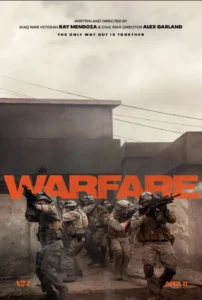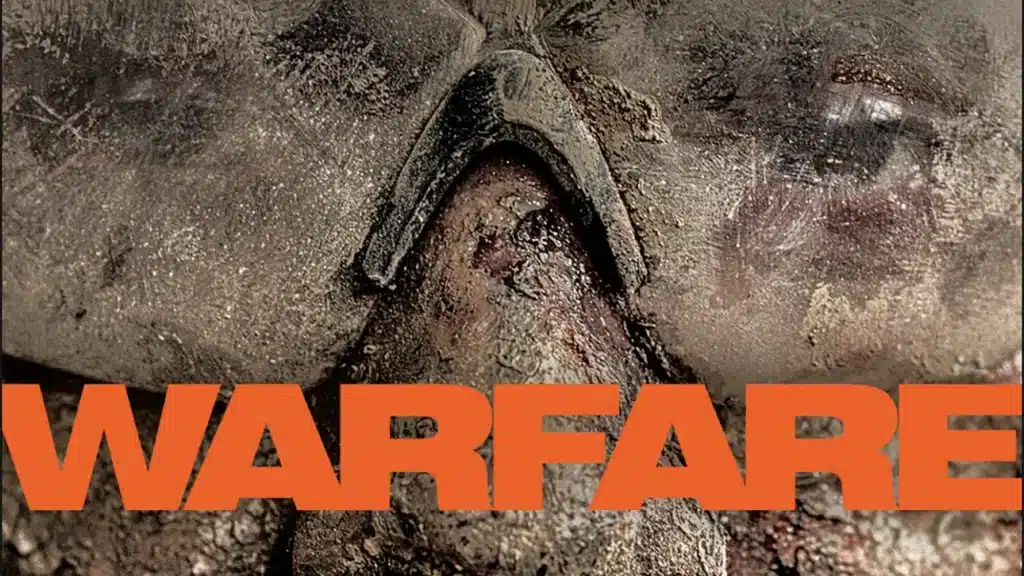
A tight and terrifying docudrama combat procedural, Ray Mendoza and Alex Garland’s Warfare tracks just one engagement in the Iraq War. The firefight was unremarkable enough to have almost certainly been forgotten by anybody not there. For the soldiers and civilians involved, however, it was likely a singular moment of their lives.
Mendoza and Garland do nothing to burden their story with external meaning. That scarcity of framing gives the film a timeless, nearly abstract sensation at certain moments when having the characters consider anything beyond the immediate need for survival would be beside the point.
That said, Warfare still vividly grounds itself in time and place. Based on the recollections of Ray Mendoza, an ex-Navy SEAL who advised Alex Garland on last year’s Civil War, the film’s on-screen text introduction explains that it takes place on one day in November 2006 during the Second Battle of Ramadi.
There’s a lot the filmmakers could have done to enlighten viewers, such as giving a timeline of the war (three years in), where Ramadi is (it’s an Iraqi city about 70 miles from Baghdad), and why the US was spending months fighting through it (it was al-Qaeda’s base in Anbar province). None of that is included in Warfare. Viewers are nevertheless grounded in the mid-2000s by a seemingly nonsensical yet somehow moving introduction showing a roomful of SEALs huddled around a laptop and giddily rocking out while watching the bump-and-grind video for Eric Prydz’s “Call on Me”.
Once the credits have rolled, Warfare moves ahead in real time, steadily elevating chaos and compounding stakes that have nothing to do with the prosecution of a war and everything to do with the survival of this squad. Having set up in a Ramadi family’s house, they stealthily infiltrated at night to set up firing positions (the family still huddled, terrified and confused, in one bedroom), the squad is ostensibly there to support some nearby Marines. In actuality, they are doing what soldiers spend most of their time doing in warzones: Waiting, waiting some more, and occasionally getting shot at for no good reason.
Mendoza and Garland patiently and with a minimum of trickery or heavy-handed foreshadowing play out the quiet before the storm. Windows are nervously watched, shades blow in the breeze, and squad sniper Elliott (Cosmo Jarvis, as usual, oddly riveting while doing very little) watches through his scope for the attack they all know is coming.
Their actions are meticulously de-romanticized. They might be elite killers, but these SEALs spend most of their time taking notes on movement and engaging in numbingly repetitive communications with surveillance operators. Once the insurgent attack comes, the moment is anticlimactic (a grenade lobbed through a window), followed not by a familiarly escalating tempo of cinematic combat representations but by a start-and-stop momentum that keeps the characters and viewer continuously off-balance.
The brutality of the firefight in the second half of Warfare is notable almost more for the psychological toll it takes than the physical violence it depicts. The flurries of small arms fire come in hammering waves as the SEALs frantically try to determine who is shooting at them and from where. For their part, the insurgents are barely seen and almost always at a distance.
The messy nature of the fighting makes for an unsettling experience shorn of the expected highs, lows, and moments of payoff. Rather than showing the SEALs accomplish a dangerous mission or take on an enemy in a resolved way, Warfare illustrates a series of gambits based around the need to evacuate one and then multiple wounded SEALs. It creates multiple white-knuckle incidents where time almost seems to stand still; there are few films where armored vehicles have moved with such emotionally wrenching slowness.
The drama is accelerated by Mendoza and Garland’s refusal to give the little bits of personalizing business most squad-level war films deem necessary to humanize their grunts (the one with the girlfriend back home, the young soldier with the weird sense of humor). This method often distances the viewer by relying on clichés.
Instead, Warfare makes its characters painfully human not through signifiers but with moments of vulnerability. These are not the SEAL supermen of countless films, books, and TV series, but highly trained soldiers who are just as susceptible to being knocked for a loop by a nearby explosion as anyone.
One of Warfare’s more impressive departures from war film stereotype is its lack of interest in passing judgment. There are no scenes where an arrogant officer learns his lesson, a blowhard’s truth is exposed, or a coward puts the rest at risk. This is a film where, after an IED shreds one character’s leg and leaves burning phosphorus inside the wound, they scream relentlessly and beg for more morphine, not to show their lack of grit, but because they are in excruciating agony, and that is when people scream.
Some might find Warfare’s unfamiliar structure and lack of closure frustrating. It contains few moments of satisfying violence. In one admittedly astounding scene, the slow, steady pounding of the Bradleys’ cannons at short range has a terrifyingly annihilating impact. A squad leader calls for an armored unit to take out the insurgent-filled second level of a building, but the result is only momentary quiet, not victory. The film closes on the action without any pretense that what happened on that Ramadi street mattered beyond how successful the men there were in trying to kill those on the other side.
That limited perspective ultimately makes the fighting presented in Warfare more human. Without a larger strategy goal, the only thing these men are there for is each other.

